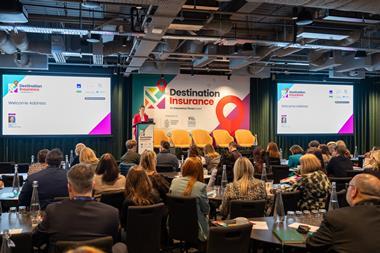In the 1990s, partnerships were fashionable throughout all sectors of business. The term "partnership" was probably one of the most abused, describing anything from normal, casual, commercial relationship to strategic joint venture. Everyone had partnerships with suppliers, customers, government and employees – even competitors if it was legally permissible. However, few proved durable in a world of consolidation, globalisation, shareholder value and brand. Scant notice was taken of partnerships when other interests were deemed more important.
The insurance market was part of this trend. Brokers had partnership status with anyone who proposed to them and insurers offered this arrangement to every broker above a certain size, with little thought for the implied obligations. It was a licence for promiscuity; partnerships were formed, dissolved, or continued to exist in name only. Few were fulfilling, long-term relationships.
In research carried out by Ernst and Young, 80% of brokers had partnering arrangements, with an average of four per broker. About 12% had more than seven partnerships. For registered brokers, there were 10,000 such arrangements in existence, yet only 38% of brokers' business was placed with partners. Brokers profess to choose partners carefully, but most collect them like serial bigamists.
Insurers felt that unless they had partnership status, they would not have a meaningful relationship and so offered them to any who would accept, without really thinking about the commitment. Rather like a young stud or insecure philanderer.
They committed to providing preferential rates, understanding the brokers' business and protecting against the vagaries of the cycle, but when it came to the crunch, self-interest took precedence. Brokers often had to take the view that clients' interests came first and had little choice but to follow the market and protect their own earnings. This was not exactly a marriage made in heaven and, indeed, when the breakdown occurred, the "woman scorned" syndrome kicked in, with both sides acting like Margaret Cook.
Expectations from partnerships are high. Brokers expect a menu of benefits, the importance of each varying with each relationship. Examples are:-
- Superior service
- Increased negotiating power
- Better rates
- Exclusivity
- Funding for marketing, technology and acquisitions
- Training
- Sharing of investment/expansion plans
- Higher commission/profit share
- Work transfer/delegation of authorities
- Access to top management – treated as a member of the family
- Product and market development assistance
- Lead generation/gifted business
- Access to free or low-cost consultancy services
In turn, insurers expect brokers to change their normal behaviour and select for their partner rather than leave them exposed to the full market forces. This should produce profitable growth. To insurers, partnership means brokers…
- Carrying higher than minimum rates
- Giving the insurer a chance to retain existing or acquire new business
- Diverting otherwise unprofitable business and acting as a front-line underwriter
- Buying into the insurer strategy and accommodating long-term problems
- Using the insurer's services
- Promoting the brand
- Nurturing tripartide relationships between insurer, broker and clients
- Allowing insurers to cherry-pick their business
These "wish lists" illustrate a number of mismatches that require compromise on both sides. No wonder many deals fail when the going gets tough.
In the new millennium, has the scenario changed? Yes – enormously: 60% of the market is dominated by four insurers, yet in the independent sector only 100 brokers control premium incomes over £5m. Over 8,000 independent intermediaries have commission incomes of less than £150,000 per annum. In view of this, partnerships are at a crossroads and need total reappraisal. The issues are:
- Can a multinational have partnership suppliers that are minnows by comparison?
- Are there enough common interests to provide a firm foundation for a durable relationship?
- Is change so constant that it is impossible for any partnership to stand the test of time?
- Is divorce so painful, it is not worth getting hitched in the first place?
- Are obligations to shareholders and clients so strong they cannot be subsumed in a bipartisan relationship between insurer/broker?
- Is the future regulatory environment such that formal relationships will be seen to act against consumer interests?
- Is consolidation reducing the number of players so rapidly that all commercial relationships become special without partnership status?
- Does the industry need a new model?
It is crucial for partnerships to survive if a long-term, win-win situation is to be engendered. This has to be built on an adult relationship founded on trust and mutual respect with common goals. It has to be a union of equals and benefit all stakeholders. There has to be commitment to succeed and make things work.
Faced with this scenario, true partnerships are likely to be few and far between. Many partnerships have been called such for marketing reasons, when, in reality, they are probably just terms of business covering a normal commercial relationship. These would include service standards, remuneration based on purchasing power, profitability benchmarks, relationship management and decision, varying, according to the importance of that relationship.
Brokers, in fact, can probably have only one real partnership alongside a number of liaisons. Larger brokers may have partnerships in various areas – commercial/personal lines or business sectors, for example – but once again these should be exclusive in their chosen areas. Insurers can only have partnerships with a limited number of brokers and these should contain an element of exclusivity, which could be classes of business, sector, delivery mechanisms or geography. If either party is unable to live with the demands and obligations of a true partnership, all parties should recognise that the relationship is purely commercial and transient, according to the needs of organisations at that particular time.
Selecting two partners should be done carefully and not be rushed. Compatibility is important and should not be given a tick-in-the-box, job-done status
The new order will mean a much more selective approach from both sides. The permanence and exclusivity of arrangements will mean that they are valued more by both parties and the partners will work at it to keep it intact in spite of changes, consolidations and outside pressures.
True partnership has benefits for both sides even if there is an imbalance of power between insurers and the independent sector, but anyone who enters into it has to do so mindful of the obligations it imposes.
--
Tony Cornell is an independent consultant and can be contacted at tony.cornell@talk21.com .
Hosted by comedian and actor Tom Allen, 34 Gold, 23 Silver and 22 Bronze awards were handed out across an amazing 34 categories recognising brilliance and innovation right across the breadth of UK general insurance.












































